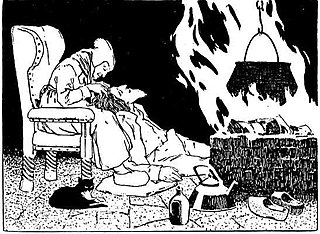Related Research Articles

In mythology, folklore and speculative fiction, shapeshifting is the ability to physically transform oneself through an inherently superhuman ability, divine intervention, demonic manipulation, sorcery, spells or having inherited the ability. The idea of shapeshifting is in the oldest forms of totemism and shamanism, as well as the oldest existent literature and epic poems such as the Epic of Gilgamesh and the Iliad. The concept remains a common literary device in modern fantasy, children's literature and popular culture.
Tatterhood is a Norwegian fairy tale collected by Peter Christen Asbjørnsen and Jørgen Moe.

"The Devil with the Three Golden Hairs" is a German fairy tale collected by the Brothers Grimm. It falls under Aarne–Thompson classification types 461, and 930.
The Golden-Headed Fish is an Armenian fairy tale. It was first collected by ethnologue and clergyman Karekin Servantsians in Hamov-Hotov (1884) with the title ԱԼԹՈՒՆ ԲԱՇ ԲԱԼԸՂ. It was later translated to English by A. G. Seklemian, and also in French by scholar Frédéric Macler. Andrew Lang included it in The Olive Fairy Book.
Why the Sea Is Salt is a Norwegian fairy tale collected by Peter Christen Asbjørnsen and Jørgen Moe in their Norske Folkeeventyr. Andrew Lang included it in The Blue Fairy Book (1889).

Go I Know Not Whither and Fetch I Know Not What is a Russian fairy tale collected by Alexander Afanasyev in Narodnye russkie skazki.
The Enchanted Watch is a French fairy tale collected by Paul Sébillot (1843–1918). Andrew Lang included it in his The Green Fairy Book (1892).
The Sleeping Prince is a Greek fairy tale collected by Georgios A. Megas in Folktales of Greece.
Beauty and Pock Face is a Chinese fairy tale collected by Wolfram Eberhard in Chinese Fairy Tales and Folk Tales.
"The Pretty Little Calf" is a Chinese fairy tale collected by Wolfram Eberhard in "Folktales of China".

Ileana Simziana or Ileana Sînziana is a Romanian fairy tale collected and written down by Petre Ispirescu between 1872 and 1886. It tells the story of an unnamed youngest daughter of an emperor, who dresses up as a man, goes to serve another emperor and rescues the titular princess Ileana. During a quest of obtaining the Holy Water she is hit by a curse of a monk that causes her to transform into a man - Făt-Frumos, who marries Ileana in the happy ending.
Gyeonmyo jaengju is a Korean folktale that has been traditionally been cited as the reason why cats and dogs fail to get along with each other. The story appears in numerous variations in several history folktale collections.

King Lindworm or Prince Lindworm is a Danish fairy tale published in the 19th century by Danish folklorist Svend Grundtvig.
The Horse-Devil and the Witch or The Horse-Dew and the Witch is a Turkish fairy tale first collected by Hungarian Turkologist Ignác Kúnos in late 19th century.
Silver Hair and Golden Curls is an Armenian folktale originally collected by ethnologue and clergyman Karekin Servantsians in Hamov-Hotov (1884). It is related to the theme of the calumniated wife and classified in the international Aarne-Thompson-Uther Index as type ATU 707, "The Three Golden Children".
The Snail Son is a character that appears in Japanese folktales, as a type of enchanted husband that becomes disenchanted from his animal form and becomes a handsome man. Some tales are related to the cycle of Animal as Bridegroom or The Search for the Lost Husband.
The Tale of the Woodcutter and his Daughters is an Egyptian folktale related to the international cycle of the Animal as Bridegroom. It mostly follows subtype ATU 425D, "The Vanished Husband", which segues into tale type ATU 425B, "The Son of the Witch", with the heroine's tasks for the supernatural husband's mother - subtypes of the more general type ATU 425, "The Search for the Lost Husband".
The King of the Snakes is a Chinese folktale published by John Macgowan in 1910. It tells the story of a woman who marries a snake spirit, but her sister conspires to take her place and kills her. The woman goes through a cycle of transformations, regains human form and takes revenge on her sister.
The Tale about Baba-Yaga is a Russian fairy tale first published in a late 18th-century compilation of fairy tales.
The Wife from the Dragon Palace is a Japanese folktale collected by scholar Yanagita Kunio. Other scholars locate similar stories in Central and East Asia.